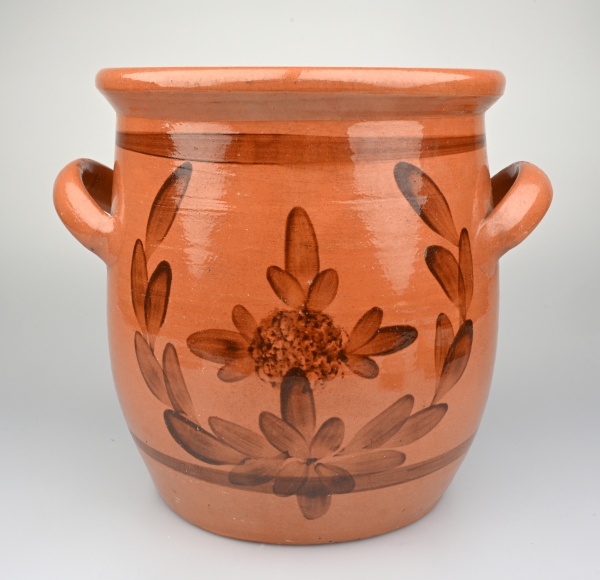

Andreas Heege with the assistance of Guido Stutz, 2023
Pottery from the Dünner pottery factory in CERAMICA CH
We have very little information on the pottery produced by Otto Dünner in Kradolf-Schönenberg. So far, no detailed study of the company’s history has ever been undertaken. However, Guido Stutz from Kradolf-Schönenberg did gather some crucial information from the locality.
In the first half of the 19th century, the potter Wilhelm Kesselring produced earthenware cups and jugs with simple decoration on Kantonsstrasse (Hauptstrasse), where the pottery factory was later situated. He also had a farm directly beside the potter’s workshop (present-day Altwegg farm). The 1862 directory lists him as “Wilh. Kesselring, potter”. In 1891, Kesselring hired Otto Dünner as a “servant boy” and taught him the basics of both farming and pottery making.
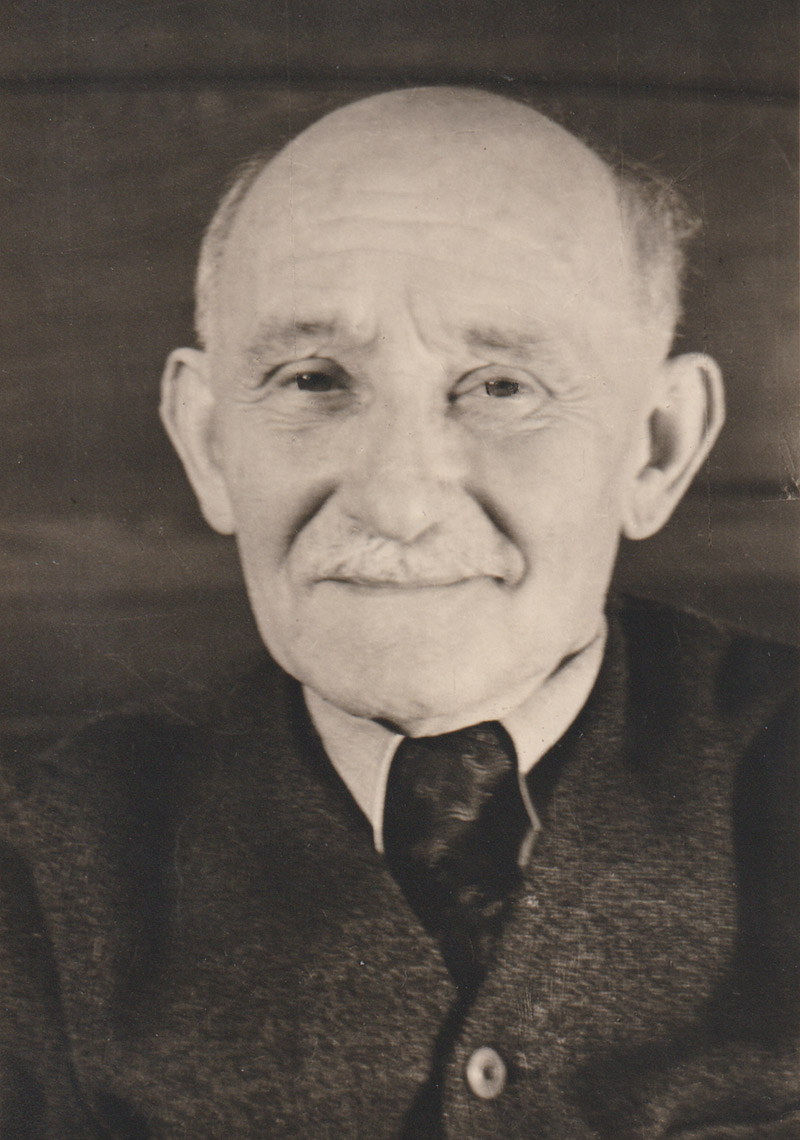
Otto Dünner, biographical dates unknown, picture taken by an anonymous photographer on an unknown date.
Because Kesselring’s son Albert did not show any interest in the pottery business, Otto Dünner took over the workshop in 1904, having worked there for 13 years. He set up his own company (Historisches Lexikon der Schweiz), which would continue to produce pottery until 1999.
The Swiss Official Gazette of Commerce contains the following information on the company:

9th November 1909, the company Otto Dünner-Haag is listed in the Swiss Official Gazette of Commerce (SOGC 27, 1909, p. 1912).
In July 1909, Otto Dünner began to advertise for staff and for a pugmill in good condition:
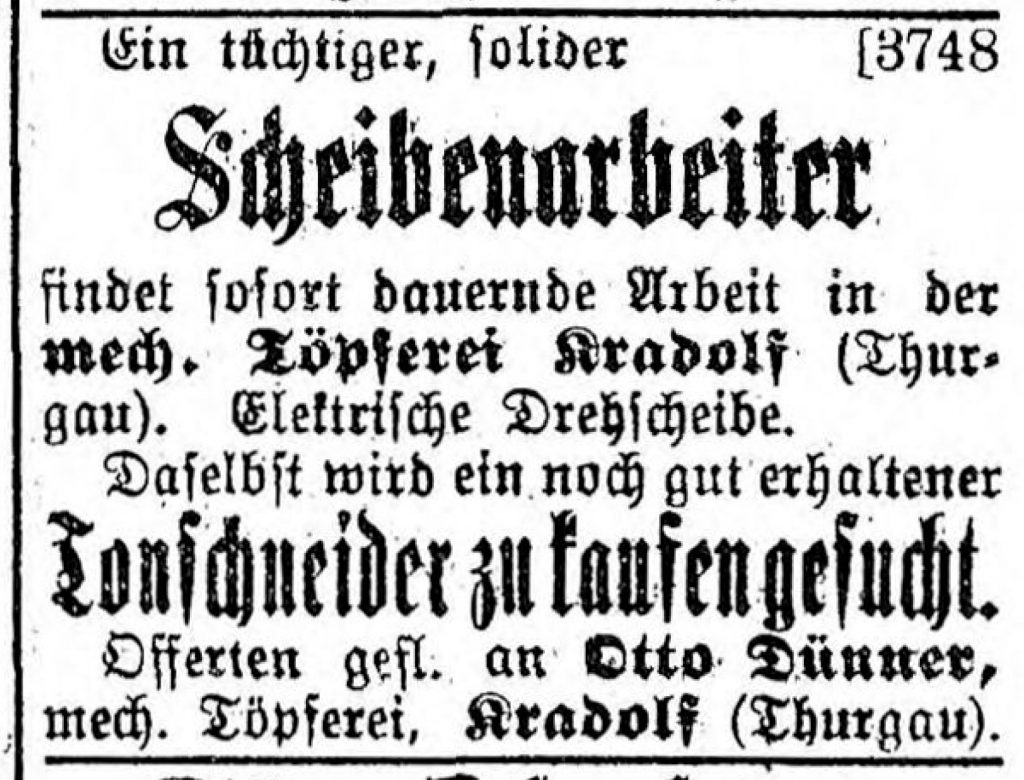
7th August 1909, job advertisement in “Der Grütlianer” newspaper.
More staff were recruited in 1911:
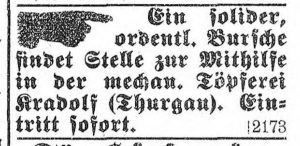
21st April 1911, job advertisement in “Der Grütlianer” newspaper.
On 23rd November 1933, disaster struck. A “large factory fire” resulted in the company, which was not sufficiently covered by insurance, being razed to the ground. Numerous daily newspapers in the German- and French-speaking parts of Switzerland reported on the fire, which destroyed the entire manufacturing building.
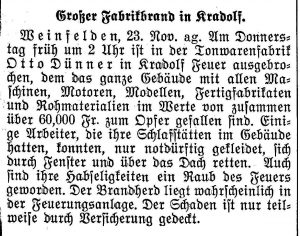
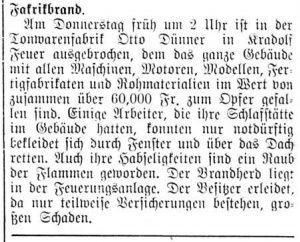
On the left: 24th November 1933, Neue Zürcher Zeitung; on the right: Walliser Bote 29th November 1933.
It is not known how long it took for the building to be restored, but the company continued production at 29 Hauptstrasse in Kradolf-Schönenberg until it closed down in 1999.
It is possible that Dünner had difficulty in securing funding for the reconstruction, and in December 1938, the firm was made a public limited company, which introduced new funds. On 20th December 1938, the Dünner Pottery Factory AG was registered in the Swiss Official Gazette of Commerce (SOGC 56, 1938, p. 2739).
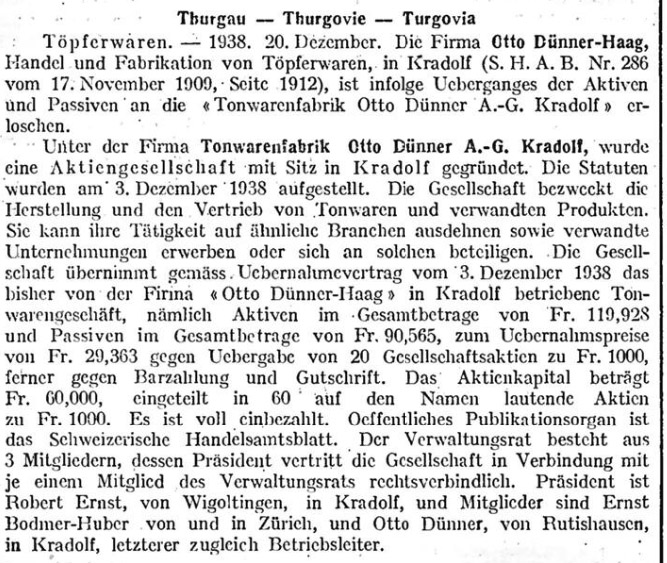
The new limited company took over all the assets and liabilities of its predecessor. Otto Dünner continued to manage the firm and received one third of the new share capital. The fact that Ernst Bodmer-Huber, the owner of a pottery factory in Zürich-Wiedikon (Bodmer-Huber/Messerli-Bolliger 1986), sat on the board of administration of the new company suggests that he also had a financial stake in it. That is why the company archive of the Bodmer factory includes numerous Dünner Pottery Factory pricelists, photographs and catalogues from the period between 1939 and 1950 (Zurich City Archive StAZH_VII-174). They provide us with a first impression of the range of pottery that was being produced in Kradolf-Schönenberg at the time.
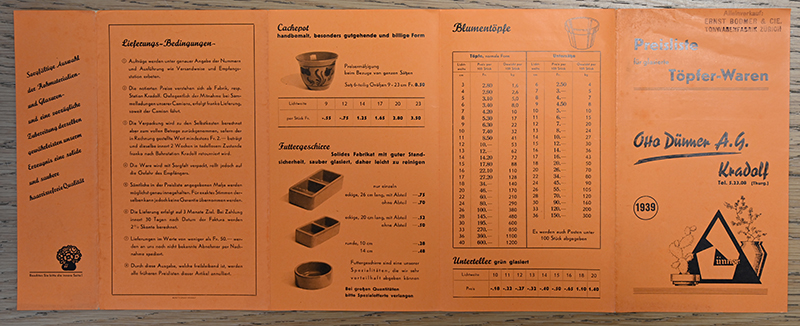
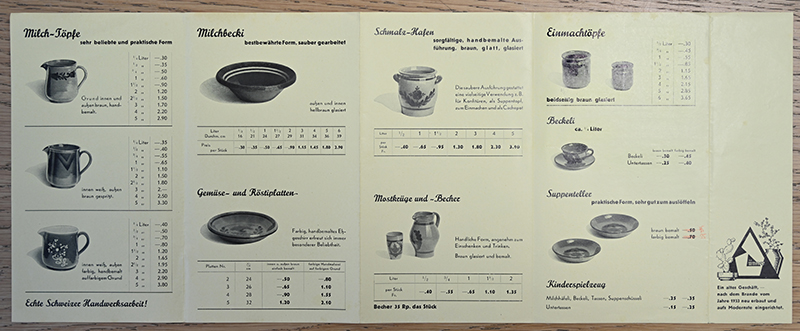
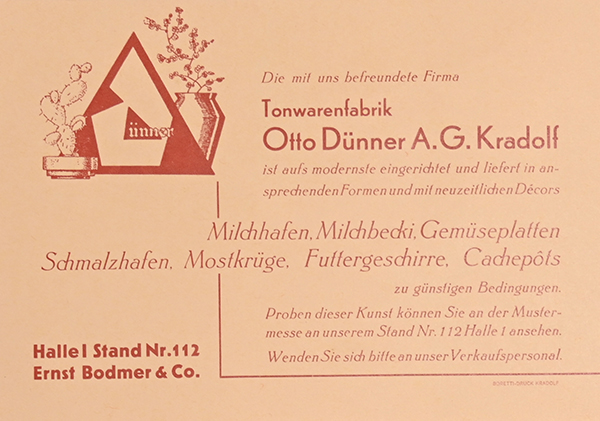
In 1939, Dünner presented his wares at the Mustermesse fair in Basel for the first time. Initially, the range of wares was quite simple and not particularly large..
Pricelist, undated, c. 1940-1950 (pdf)
Pricelist, undated, c. 1940-1950 (pdf)
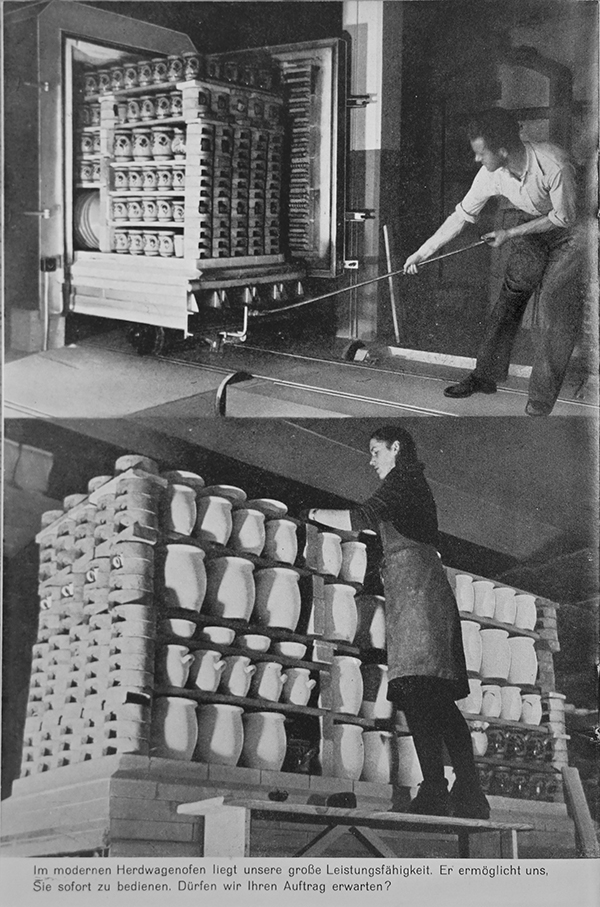
Bogie hearth furnace, picture in a catalogue from just before 1950.
Business was good, and this allowed the company to construct two new electric chamber kilns, which were later fitted with bogies that made it easier to charge them.
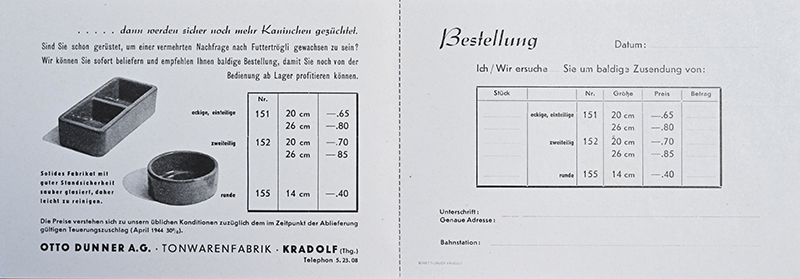
Advertising card, undated c. 1940-1945 (pdf)
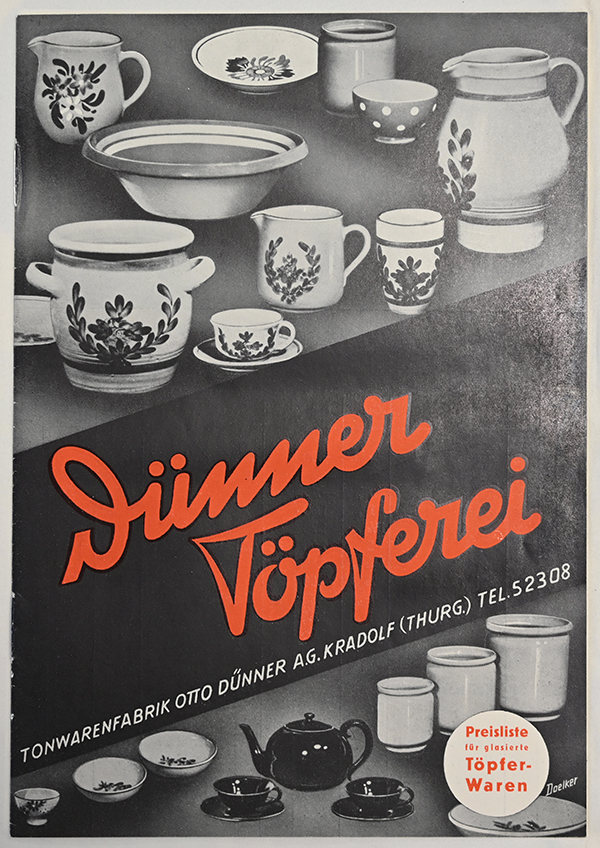
The 1941 catalogue shows how the pottery factory was beginning to target the local Swiss economy because of the war and is an important witness to the period.
Catalogue and pricelist 1941 (pdf)
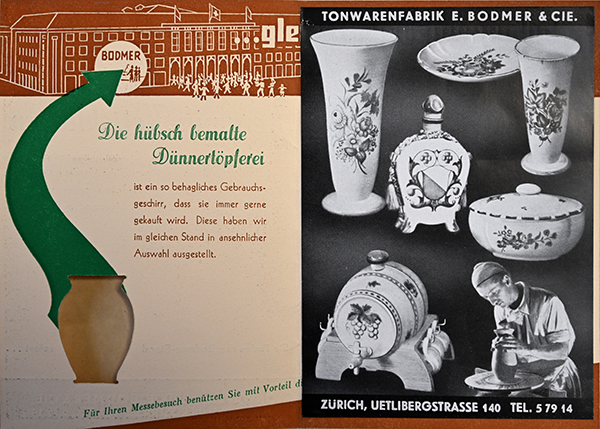
The companies Bodmer and Dünner regularly collaborated in displaying their wares at the Mustermesse fair in Basel (MUBA) (this example dates from 1942). At the same time, the old pricelists were re-issued with increases due to the war..
Catalogue and pricelist, 1942 (pdf)
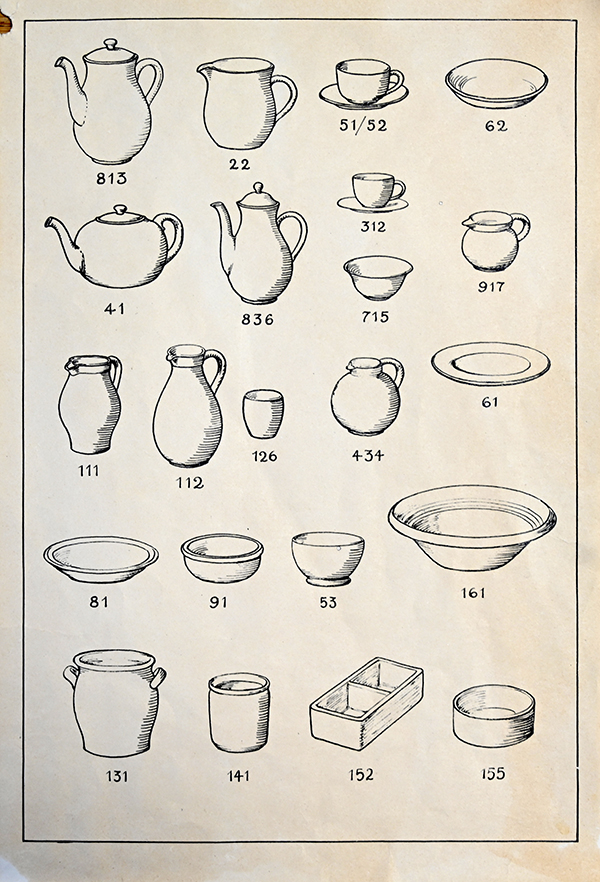
The 1943 pricelist was copied rather than printed but line drawings of the available shapes were added.
Catalogue and pricelist 1943 (pdf)
In 1945, the 1941 catalogue of the Dünner company was re-issued unchanged for the last time.
Catalogue and preicelist 1945 (pdf)
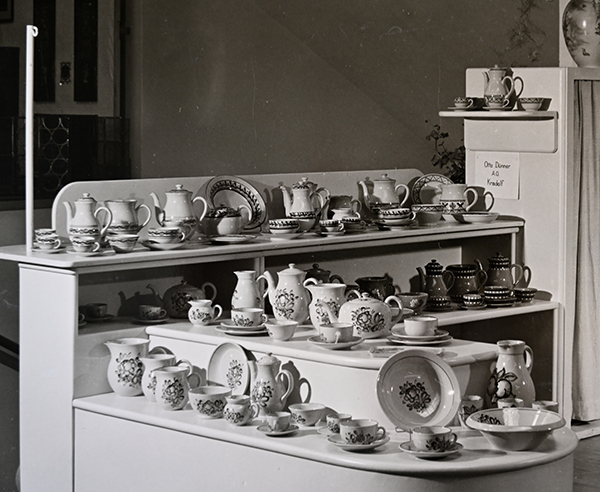
A photograph of the stand at the 1946 Mustermesse fair in Basel has survived. It shows that year’s range of wares and decorations.
In 1947/1948, a new catalogue with a pricelist was printed, though it contained the same range of wares as those shown at the 1946 MUBA.
Catalogue and pricelist 1947/1948 (pdf).
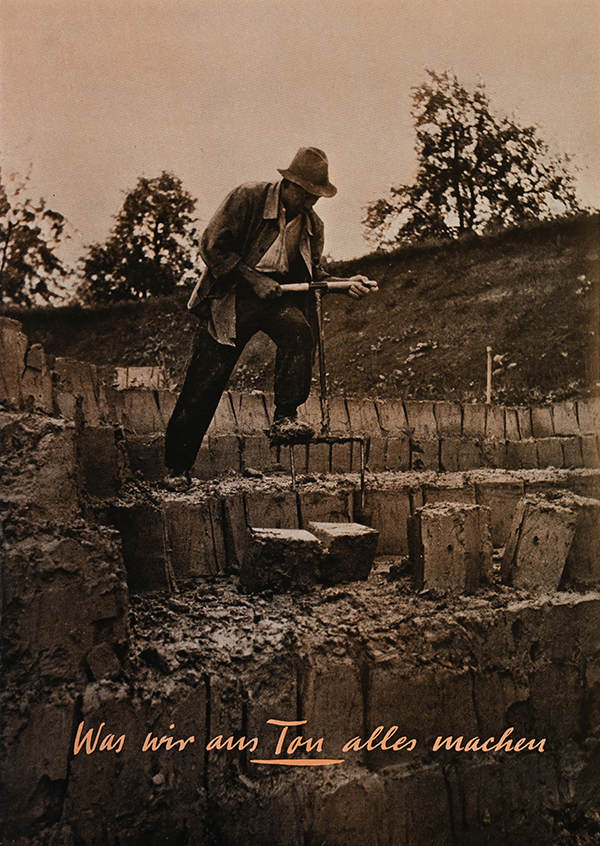
In c. 1950, the products of the Dünner pottery factory were also included in a corporate brochure published by the company Bodmer and Cie.
Undated corporate brochure, c.1950.
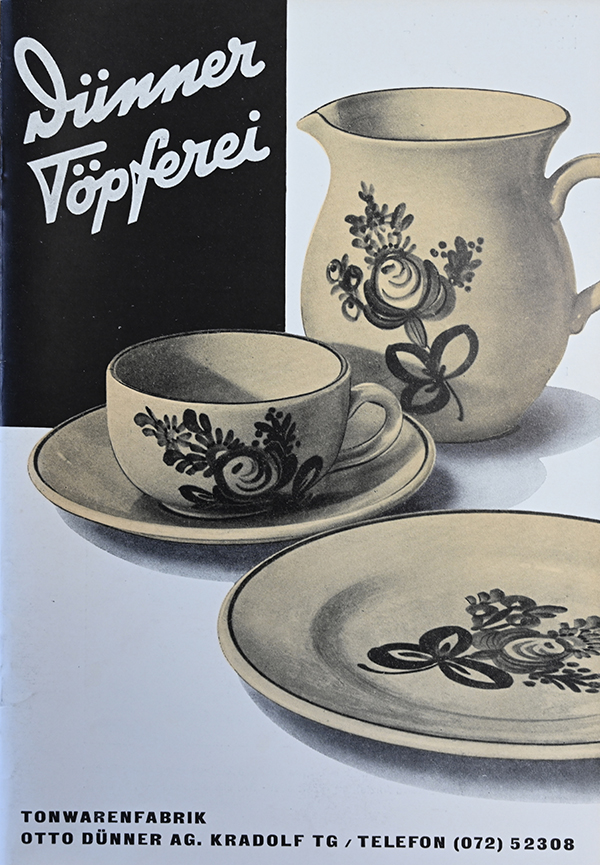
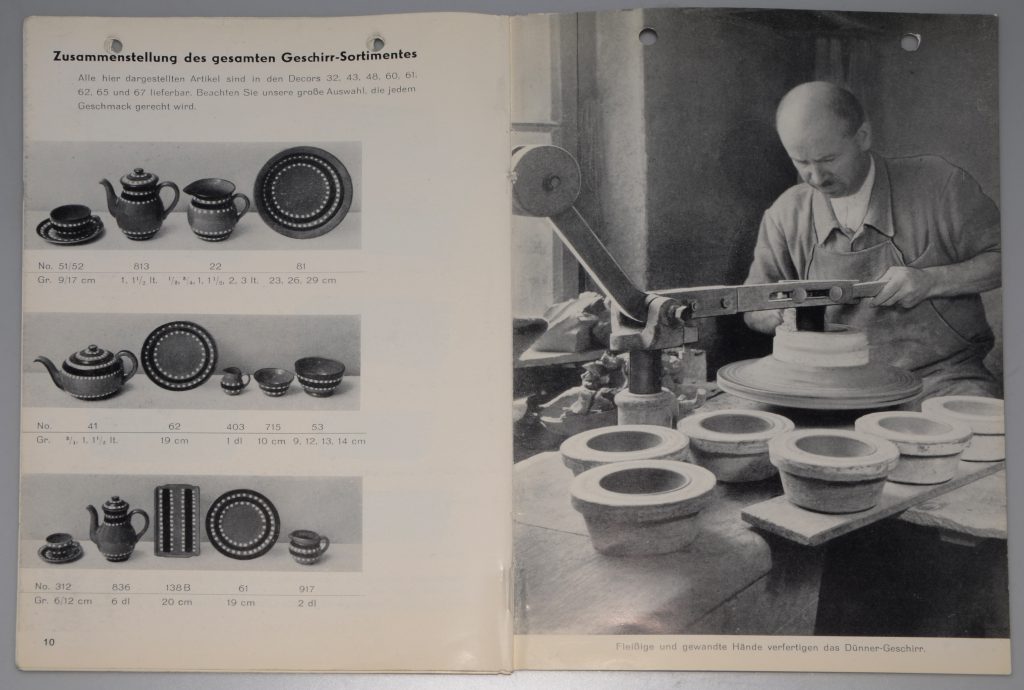
The final pricelist in association with the firm Bodmer & Cie was printed in c. 1950. It includes a member of staff using a jigger jolly machine to press the vessels into moulds made of plaster of Paris. The factory was beginning to at least partially mechanise its production.
Undated catalogue, c. 1950 (pdf).
Undated pricelist, c. 1950 (pdf).
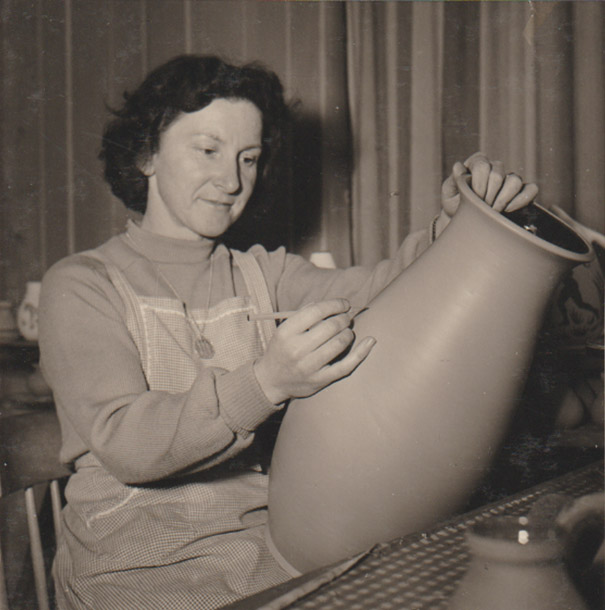
Elsy Lang, a talented artist, decorated everything by hand, even the larger commissions.
In 1950, the company once again changed ownership, although this is not very clear from the Swiss Official Gazette of Commerce (SOGC 68, 1950, p. 2231):

In fact, this meant that the Dünner Pottery Factory (i.e. the public limited company) was taken over by Emil Rössler, an industrialist from Ersigen in the Emmental valley ((Rössler company history 1978). In 1960, he also bought the pottery factory in Matzendorf-Aedermannsdorf.
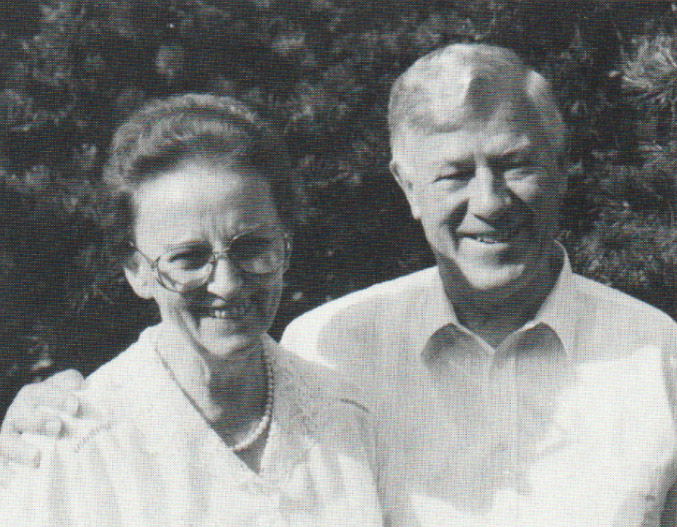
Paul and Meta Dürig-Weiss; Paul managed the company while Meta worked in the office for 41 years and also helped out on the shop floor whenever the need arose.
Paul Dürig became the company director. In subsequent years, the factory buildings were regularly extended and renovated, and new sections were constructed.
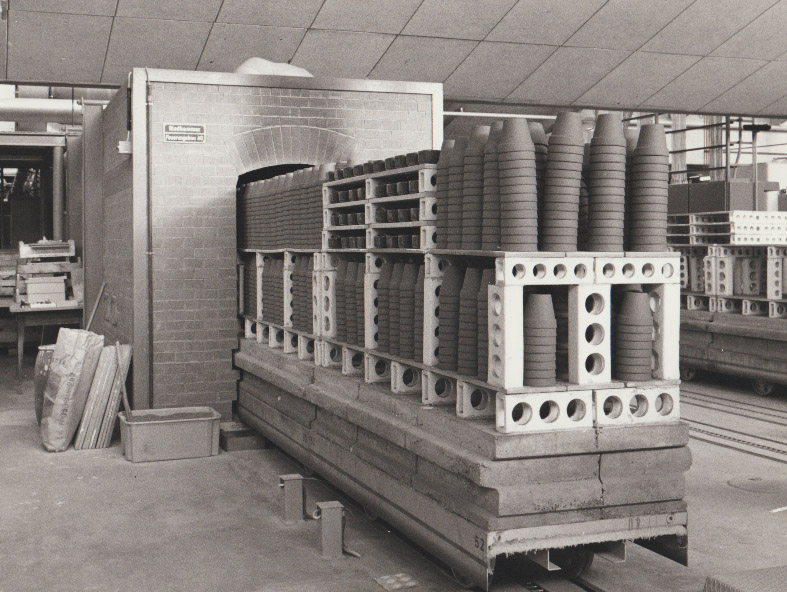
A pusher kiln increased the number of vessels that could be mass-produced and allowed the company to make up to 20,000 flower pots per day.
From the 1950s onwards, growing competition forced the company to move towards mass-production. The fully automated plant produced small feeding troughs, flower pots, bowls and dross filters. In the 1960s, the latter were much sought-after as production aids for foundries. Almost all foundries in Switzerland, as well as some from as far afield as Austria and Belgium, bought their filters from the company (some 1.5 million filters were produced annually).
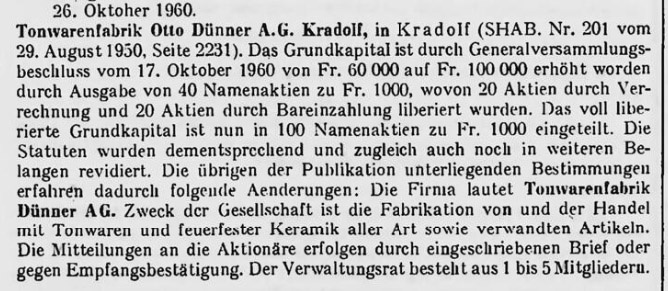

The share capital increased considerably in 1960 and again in 1964 (SOGC 78, 1960, p. 3129; SOGC 82, 1964, p. 3077).
In 1964, the company was able to take over the customer base of the former Thayngen pottery factory, and when the Heinrich Ganz company in Freienstein closed down in 1985, yet another list of clients was added.
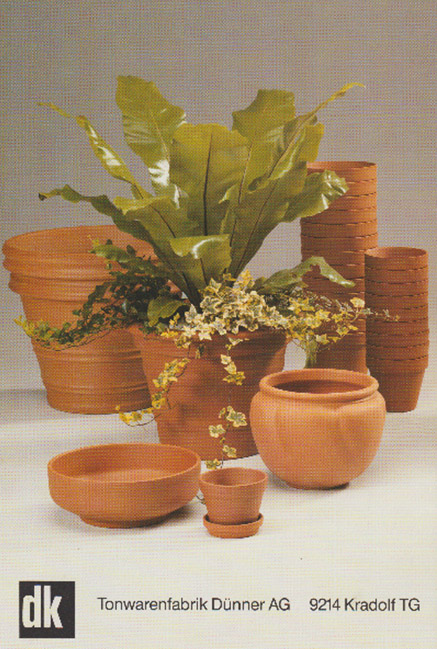
In 1967, the Dünner pottery factory produced some 4.5 million flower pots (approximately one quarter of the total annual production in Switzerland).

Emil and Willy Rössler, who had taken over their father’s company Rössler AG, became members of the board of administration of the Dünner pottery factory in 1969 (SOGC 87, 1969, p. 1177). By 1978, the company in Kradolf employed 20 members of staff.
In 1992, Paul Dürig junior, a ceramics engineer, took over as technical manager of the company, in which he had already been employed for more than 20 years. Only seven years later, however, the company in Kradolf also became a victim of the competition from abroad. At times, it had employed up to 30 people, and it was not until 3rd April 2018 that the General Assembly initiated the process of dissolving the company. It was deleted from the register of Swiss companies on 5th March 2020.
The information about the company’s products as taken from the brochures listed above and from a small number of ceramics with the characteristic Dünner patterns or marks is rather scant. The range included jugs (a cider service), cups, pots, vases and figures with hand-painted patterns or with incised decorations executed using a special technique. The company also produced flower pots and other garden ceramics.
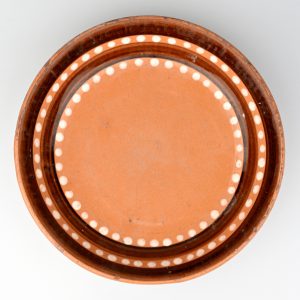
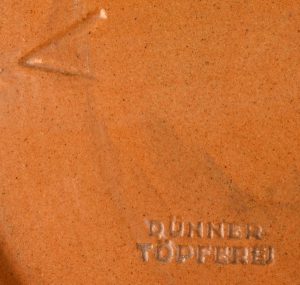
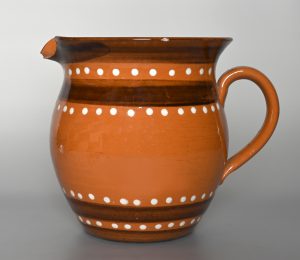
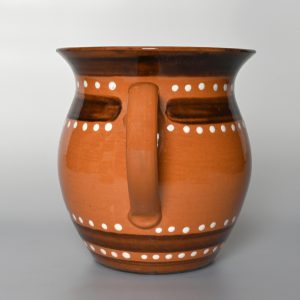
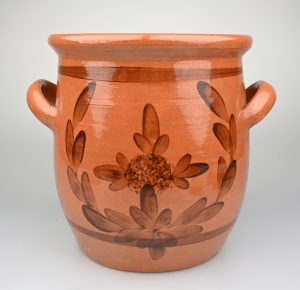

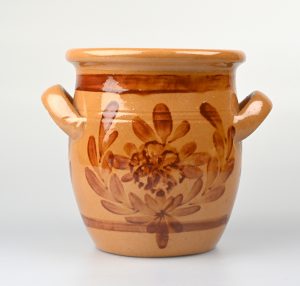
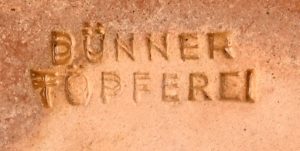
Were these two-handled jars made to replace similar “Westerwald-type” stoneware storage pots which had become very difficult or even impossible to import from the Alsace in France or the Westerwald region in Germany during the Second World War?
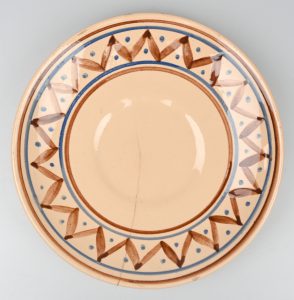

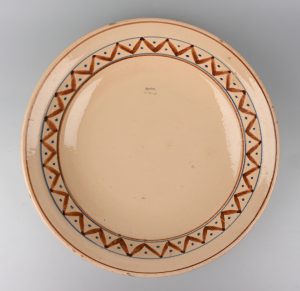
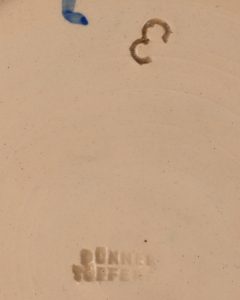
Acknowledgements
I am grateful to Guido Stutz and the Zurich City Archive, which houses numerous catalogues and company brochures among the documents from the pottery factory Bodmer & Cie. (StAZH_VII-174), for their assistance in gathering the information presented here.
Translation Sandy Haemmerle
References:
Bodmer-Huber/Messerli-Bolliger 1986
Ernst Bodmer-Huber/Barbara E. Messerli-Bolliger, Die Tonwarenfabrik Bodmer in Zürich-Wiedikon Geschichte, Produktion, Firmeninhaber, Entwerfer, in: Keramikfreunde der Schweiz, Mitteilungsblatt, 101. Jahrgang, 1986, 1-60.
Stutz 2022
Guido Stutz, Kradolf in Geschichte und Geschichten. Kradolf-Schönenberg 2022.

